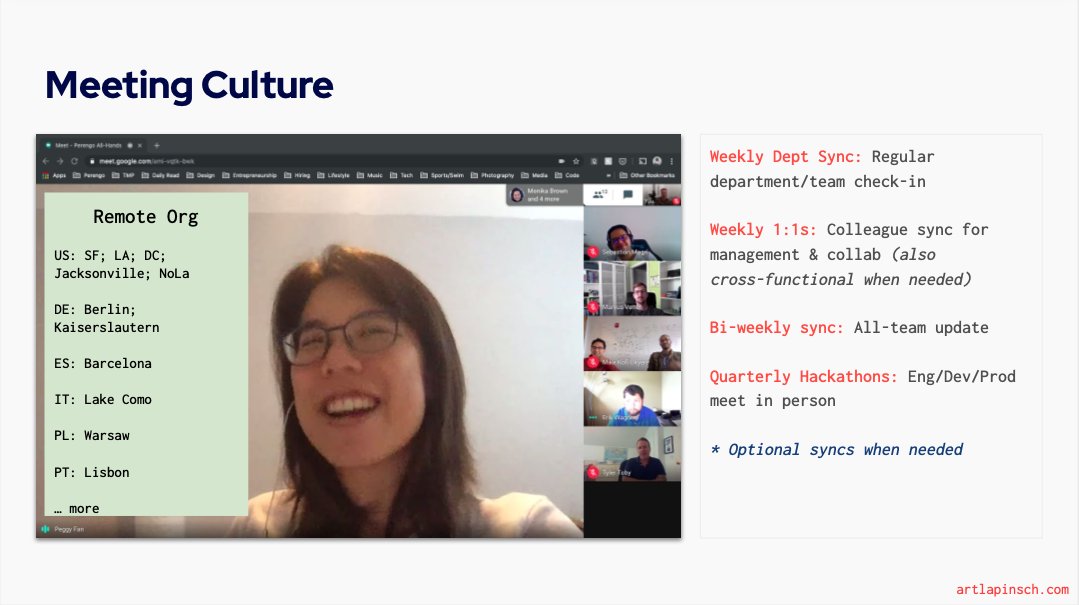On Tuesday I hosted a @ondeck #ODCC1 community session about & #39;Remote Company Building& #39;
Topics:
 https://abs.twimg.com/emoji/v2/... draggable="false" alt="📘" title="Blaues Buch" aria-label="Emoji: Blaues Buch"> Guiding Principles
https://abs.twimg.com/emoji/v2/... draggable="false" alt="📘" title="Blaues Buch" aria-label="Emoji: Blaues Buch"> Guiding Principles
 https://abs.twimg.com/emoji/v2/... draggable="false" alt="🖥️" title="Desktop-Computer" aria-label="Emoji: Desktop-Computer"> Use Cases
https://abs.twimg.com/emoji/v2/... draggable="false" alt="🖥️" title="Desktop-Computer" aria-label="Emoji: Desktop-Computer"> Use Cases
 https://abs.twimg.com/emoji/v2/... draggable="false" alt="🧰" title="Toolbox" aria-label="Emoji: Toolbox"> Tools
https://abs.twimg.com/emoji/v2/... draggable="false" alt="🧰" title="Toolbox" aria-label="Emoji: Toolbox"> Tools
This thread is a walk through the presentation https://abs.twimg.com/emoji/v2/... draggable="false" alt="👇" title="Rückhand Zeigefinger nach unten" aria-label="Emoji: Rückhand Zeigefinger nach unten">
https://abs.twimg.com/emoji/v2/... draggable="false" alt="👇" title="Rückhand Zeigefinger nach unten" aria-label="Emoji: Rückhand Zeigefinger nach unten">
Topics:
This thread is a walk through the presentation
Our company - Perengo Inc - was remote from day 1.
Founders in Bay Area & D.C.
Team in Germany and Poland
 https://abs.twimg.com/emoji/v2/... draggable="false" alt="🕰️" title="Kamin-Uhr" aria-label="Emoji: Kamin-Uhr"> Time difference of 9 hours
https://abs.twimg.com/emoji/v2/... draggable="false" alt="🕰️" title="Kamin-Uhr" aria-label="Emoji: Kamin-Uhr"> Time difference of 9 hours
Grew team from 0 to 15 employees.
Post-acquisition (2019) remained remote as separate business unit and doubled headcount.
Founders in Bay Area & D.C.
Team in Germany and Poland
Grew team from 0 to 15 employees.
Post-acquisition (2019) remained remote as separate business unit and doubled headcount.
Most important principle of remote management:
 https://abs.twimg.com/emoji/v2/... draggable="false" alt="👉" title="Rückhand Zeigefinger nach rechts" aria-label="Emoji: Rückhand Zeigefinger nach rechts"> Optimize for Single-Player Mode
https://abs.twimg.com/emoji/v2/... draggable="false" alt="👉" title="Rückhand Zeigefinger nach rechts" aria-label="Emoji: Rückhand Zeigefinger nach rechts"> Optimize for Single-Player Mode  https://abs.twimg.com/emoji/v2/... draggable="false" alt="👈" title="Rückhand Zeigefinger nach links" aria-label="Emoji: Rückhand Zeigefinger nach links">
https://abs.twimg.com/emoji/v2/... draggable="false" alt="👈" title="Rückhand Zeigefinger nach links" aria-label="Emoji: Rückhand Zeigefinger nach links">
> Provide direction for your team
> Give access to necessary tools and info
> Enable your team to get work done on their own
h/t @andreasklinger for popularizing this idea
> Provide direction for your team
> Give access to necessary tools and info
> Enable your team to get work done on their own
h/t @andreasklinger for popularizing this idea
Businesses can be analyzed across 2 dimensions
1) Location: Co-located vs. Distributed
2) Synchronicity of Work: Synchronous vs. Asynchronous
Remote first https://abs.twimg.com/emoji/v2/... draggable="false" alt="🏝️" title="Einsame Insel" aria-label="Emoji: Einsame Insel"> orgs are usually distributed + async
https://abs.twimg.com/emoji/v2/... draggable="false" alt="🏝️" title="Einsame Insel" aria-label="Emoji: Einsame Insel"> orgs are usually distributed + async
h/t @leonardofed
1) Location: Co-located vs. Distributed
2) Synchronicity of Work: Synchronous vs. Asynchronous
Remote first
h/t @leonardofed
No need to reinvent the wheel.
Learn from the best:
@gitlab - Best employee handbook in the game
@buffer - Best org transparency via blog
@zapier - Best guide to remote work
Also, follow @darrenmurph @chris_herd @andreasklinger
Learn from the best:
@gitlab - Best employee handbook in the game
@buffer - Best org transparency via blog
@zapier - Best guide to remote work
Also, follow @darrenmurph @chris_herd @andreasklinger
Our guiding principles:
 https://abs.twimg.com/emoji/v2/... draggable="false" alt="🕶️" title="Dunkle Sonnenbrille" aria-label="Emoji: Dunkle Sonnenbrille"> C.S.I.
https://abs.twimg.com/emoji/v2/... draggable="false" alt="🕶️" title="Dunkle Sonnenbrille" aria-label="Emoji: Dunkle Sonnenbrille"> C.S.I.
 https://abs.twimg.com/emoji/v2/... draggable="false" alt="⚡" title="Hochspannungszeichen" aria-label="Emoji: Hochspannungszeichen"> A.C.D.C.
https://abs.twimg.com/emoji/v2/... draggable="false" alt="⚡" title="Hochspannungszeichen" aria-label="Emoji: Hochspannungszeichen"> A.C.D.C.
 https://abs.twimg.com/emoji/v2/... draggable="false" alt="🌹" title="Rose" aria-label="Emoji: Rose"> R.O.S.A.
https://abs.twimg.com/emoji/v2/... draggable="false" alt="🌹" title="Rose" aria-label="Emoji: Rose"> R.O.S.A.
Detailed description in the image https://abs.twimg.com/emoji/v2/... draggable="false" alt="👇" title="Rückhand Zeigefinger nach unten" aria-label="Emoji: Rückhand Zeigefinger nach unten">
https://abs.twimg.com/emoji/v2/... draggable="false" alt="👇" title="Rückhand Zeigefinger nach unten" aria-label="Emoji: Rückhand Zeigefinger nach unten">
Detailed description in the image
Communication is the life blood of any organization
View through OODA Loop:
 https://abs.twimg.com/emoji/v2/... draggable="false" alt="🔍" title="Nach links zeigende Lupe" aria-label="Emoji: Nach links zeigende Lupe"> Observe: Metrics; Sales
https://abs.twimg.com/emoji/v2/... draggable="false" alt="🔍" title="Nach links zeigende Lupe" aria-label="Emoji: Nach links zeigende Lupe"> Observe: Metrics; Sales
 https://abs.twimg.com/emoji/v2/... draggable="false" alt="📊" title="Balkendiagramm" aria-label="Emoji: Balkendiagramm"> Orient: MKTG
https://abs.twimg.com/emoji/v2/... draggable="false" alt="📊" title="Balkendiagramm" aria-label="Emoji: Balkendiagramm"> Orient: MKTG
 https://abs.twimg.com/emoji/v2/... draggable="false" alt="✅" title="Fettes weißes Häkchen" aria-label="Emoji: Fettes weißes Häkchen"> Decide: Management
https://abs.twimg.com/emoji/v2/... draggable="false" alt="✅" title="Fettes weißes Häkchen" aria-label="Emoji: Fettes weißes Häkchen"> Decide: Management
 https://abs.twimg.com/emoji/v2/... draggable="false" alt="🥊" title="Boxhandschuh" aria-label="Emoji: Boxhandschuh"> Act: Product; Sales
https://abs.twimg.com/emoji/v2/... draggable="false" alt="🥊" title="Boxhandschuh" aria-label="Emoji: Boxhandschuh"> Act: Product; Sales
If information is siloed, you cannot go through the adaptation cycles as a collective org.
Follow @commandodev
View through OODA Loop:
If information is siloed, you cannot go through the adaptation cycles as a collective org.
Follow @commandodev
Different types of communication require different channels
Think of comms along 2 dimensions:
 https://abs.twimg.com/emoji/v2/... draggable="false" alt="🔊" title="Lautsprecher mit drei Schallwellen" aria-label="Emoji: Lautsprecher mit drei Schallwellen"> Reach: 1 vs. N
https://abs.twimg.com/emoji/v2/... draggable="false" alt="🔊" title="Lautsprecher mit drei Schallwellen" aria-label="Emoji: Lautsprecher mit drei Schallwellen"> Reach: 1 vs. N
 https://abs.twimg.com/emoji/v2/... draggable="false" alt="👀" title="Augen" aria-label="Emoji: Augen"> Context: Sync (= immediate feedback needed) vs. Async (= self-paced)
https://abs.twimg.com/emoji/v2/... draggable="false" alt="👀" title="Augen" aria-label="Emoji: Augen"> Context: Sync (= immediate feedback needed) vs. Async (= self-paced)
* Transactional > Slack
* Evergreen (solid-state) > Wiki; Notion
Think of comms along 2 dimensions:
* Transactional > Slack
* Evergreen (solid-state) > Wiki; Notion
Build your comms culture deliberately
To & #39;optimize for single player mode& #39; we reduced meetings to a minimum.
The only all-hands meeting was a bi-weekly sync.
Self-org syncs between collaborators and within teams.
Other information relayed via written async comms.
To & #39;optimize for single player mode& #39; we reduced meetings to a minimum.
The only all-hands meeting was a bi-weekly sync.
Self-org syncs between collaborators and within teams.
Other information relayed via written async comms.
I have written in more detail about our business-specific workflows in this blog post  https://abs.twimg.com/emoji/v2/... draggable="false" alt="👇" title="Rückhand Zeigefinger nach unten" aria-label="Emoji: Rückhand Zeigefinger nach unten"> https://www.artlapinsch.com/remote-lessons/ ">https://www.artlapinsch.com/remote-le...
https://abs.twimg.com/emoji/v2/... draggable="false" alt="👇" title="Rückhand Zeigefinger nach unten" aria-label="Emoji: Rückhand Zeigefinger nach unten"> https://www.artlapinsch.com/remote-lessons/ ">https://www.artlapinsch.com/remote-le...
I have written in more detail about communication for remote companies in this blog post  https://abs.twimg.com/emoji/v2/... draggable="false" alt="👇" title="Rückhand Zeigefinger nach unten" aria-label="Emoji: Rückhand Zeigefinger nach unten"> (Part 1 of a series of posts) https://www.artlapinsch.com/remote-communication-ooda/">https://www.artlapinsch.com/remote-co...
https://abs.twimg.com/emoji/v2/... draggable="false" alt="👇" title="Rückhand Zeigefinger nach unten" aria-label="Emoji: Rückhand Zeigefinger nach unten"> (Part 1 of a series of posts) https://www.artlapinsch.com/remote-communication-ooda/">https://www.artlapinsch.com/remote-co...
If you enjoyed this thread, I would appreciate a retweet or a comment  https://abs.twimg.com/emoji/v2/... draggable="false" alt="🙏" title="Gefaltete Hände" aria-label="Emoji: Gefaltete Hände">
https://abs.twimg.com/emoji/v2/... draggable="false" alt="🙏" title="Gefaltete Hände" aria-label="Emoji: Gefaltete Hände">
If you want to keep in touch, please follow me and let& #39;s be friends. DMs are open.
If you want to keep in touch, please follow me and let& #39;s be friends. DMs are open.

 Read on Twitter
Read on Twitter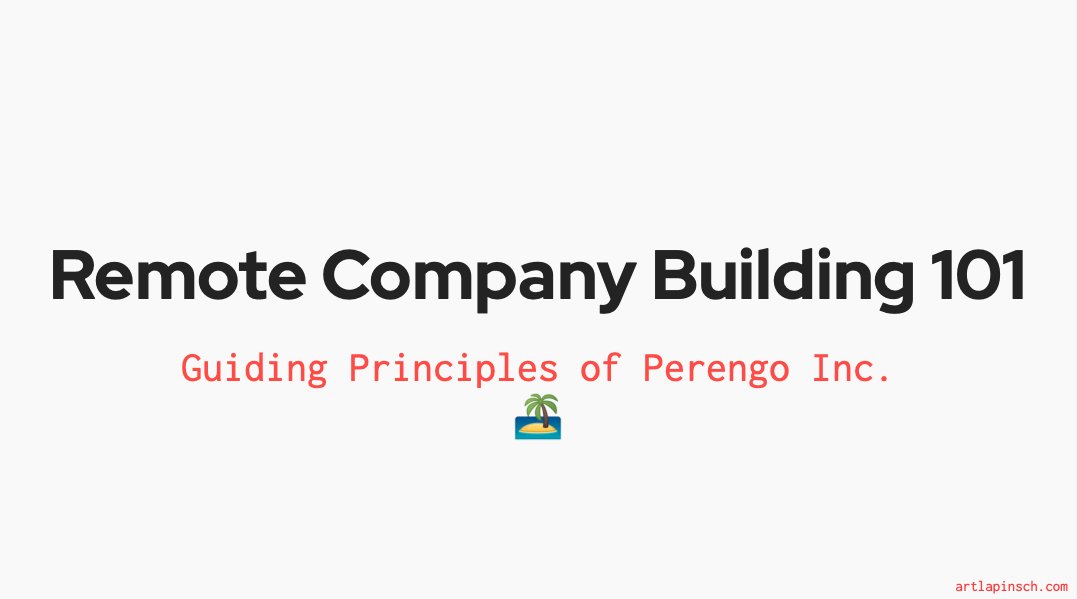 Guiding Principleshttps://abs.twimg.com/emoji/v2/... draggable="false" alt="🖥️" title="Desktop-Computer" aria-label="Emoji: Desktop-Computer"> Use Caseshttps://abs.twimg.com/emoji/v2/... draggable="false" alt="🧰" title="Toolbox" aria-label="Emoji: Toolbox"> ToolsThis thread is a walk through the presentation https://abs.twimg.com/emoji/v2/... draggable="false" alt="👇" title="Rückhand Zeigefinger nach unten" aria-label="Emoji: Rückhand Zeigefinger nach unten">" title="On Tuesday I hosted a @ondeck #ODCC1 community session about & #39;Remote Company Building& #39;Topics:https://abs.twimg.com/emoji/v2/... draggable="false" alt="📘" title="Blaues Buch" aria-label="Emoji: Blaues Buch"> Guiding Principleshttps://abs.twimg.com/emoji/v2/... draggable="false" alt="🖥️" title="Desktop-Computer" aria-label="Emoji: Desktop-Computer"> Use Caseshttps://abs.twimg.com/emoji/v2/... draggable="false" alt="🧰" title="Toolbox" aria-label="Emoji: Toolbox"> ToolsThis thread is a walk through the presentation https://abs.twimg.com/emoji/v2/... draggable="false" alt="👇" title="Rückhand Zeigefinger nach unten" aria-label="Emoji: Rückhand Zeigefinger nach unten">" class="img-responsive" style="max-width:100%;"/>
Guiding Principleshttps://abs.twimg.com/emoji/v2/... draggable="false" alt="🖥️" title="Desktop-Computer" aria-label="Emoji: Desktop-Computer"> Use Caseshttps://abs.twimg.com/emoji/v2/... draggable="false" alt="🧰" title="Toolbox" aria-label="Emoji: Toolbox"> ToolsThis thread is a walk through the presentation https://abs.twimg.com/emoji/v2/... draggable="false" alt="👇" title="Rückhand Zeigefinger nach unten" aria-label="Emoji: Rückhand Zeigefinger nach unten">" title="On Tuesday I hosted a @ondeck #ODCC1 community session about & #39;Remote Company Building& #39;Topics:https://abs.twimg.com/emoji/v2/... draggable="false" alt="📘" title="Blaues Buch" aria-label="Emoji: Blaues Buch"> Guiding Principleshttps://abs.twimg.com/emoji/v2/... draggable="false" alt="🖥️" title="Desktop-Computer" aria-label="Emoji: Desktop-Computer"> Use Caseshttps://abs.twimg.com/emoji/v2/... draggable="false" alt="🧰" title="Toolbox" aria-label="Emoji: Toolbox"> ToolsThis thread is a walk through the presentation https://abs.twimg.com/emoji/v2/... draggable="false" alt="👇" title="Rückhand Zeigefinger nach unten" aria-label="Emoji: Rückhand Zeigefinger nach unten">" class="img-responsive" style="max-width:100%;"/>
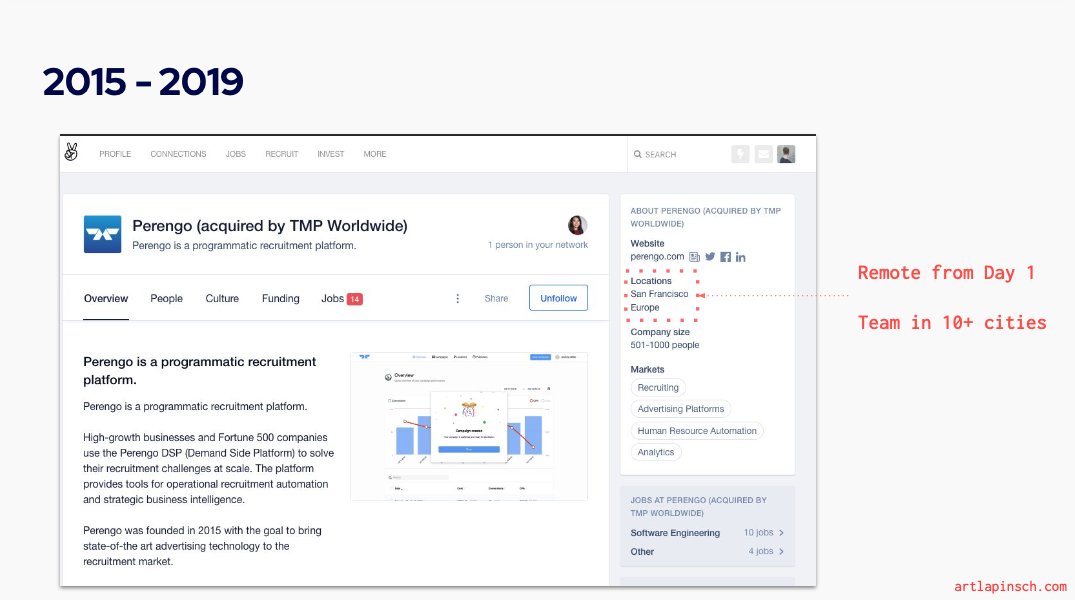 Time difference of 9 hoursGrew team from 0 to 15 employees. Post-acquisition (2019) remained remote as separate business unit and doubled headcount." title="Our company - Perengo Inc - was remote from day 1.Founders in Bay Area & D.C.Team in Germany and Polandhttps://abs.twimg.com/emoji/v2/... draggable="false" alt="🕰️" title="Kamin-Uhr" aria-label="Emoji: Kamin-Uhr"> Time difference of 9 hoursGrew team from 0 to 15 employees. Post-acquisition (2019) remained remote as separate business unit and doubled headcount." class="img-responsive" style="max-width:100%;"/>
Time difference of 9 hoursGrew team from 0 to 15 employees. Post-acquisition (2019) remained remote as separate business unit and doubled headcount." title="Our company - Perengo Inc - was remote from day 1.Founders in Bay Area & D.C.Team in Germany and Polandhttps://abs.twimg.com/emoji/v2/... draggable="false" alt="🕰️" title="Kamin-Uhr" aria-label="Emoji: Kamin-Uhr"> Time difference of 9 hoursGrew team from 0 to 15 employees. Post-acquisition (2019) remained remote as separate business unit and doubled headcount." class="img-responsive" style="max-width:100%;"/>
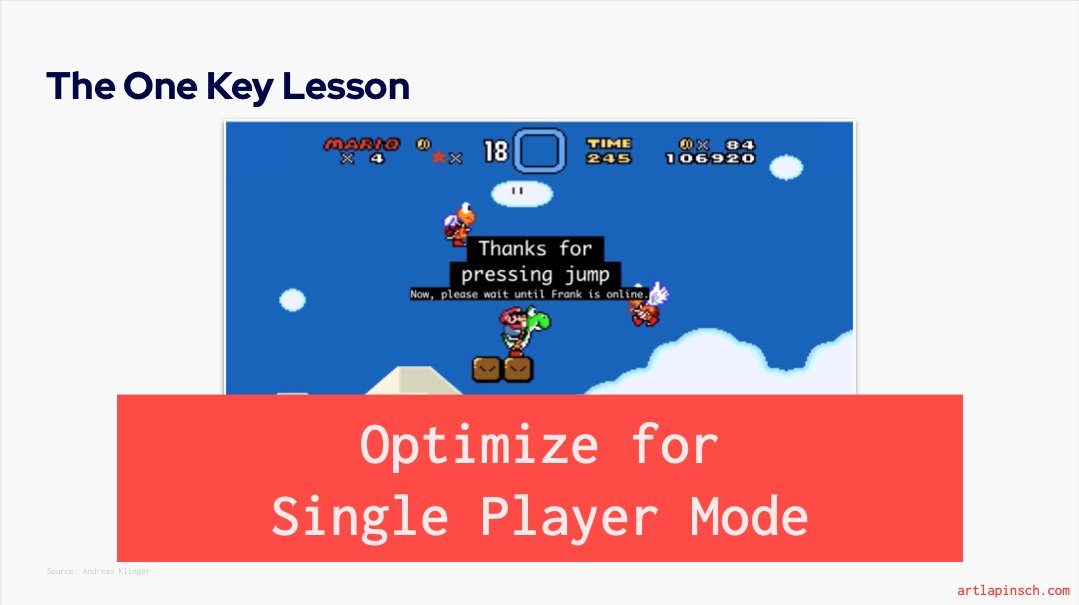 Optimize for Single-Player Mode https://abs.twimg.com/emoji/v2/... draggable="false" alt="👈" title="Rückhand Zeigefinger nach links" aria-label="Emoji: Rückhand Zeigefinger nach links">> Provide direction for your team> Give access to necessary tools and info> Enable your team to get work done on their ownh/t @andreasklinger for popularizing this idea" title="Most important principle of remote management:https://abs.twimg.com/emoji/v2/... draggable="false" alt="👉" title="Rückhand Zeigefinger nach rechts" aria-label="Emoji: Rückhand Zeigefinger nach rechts"> Optimize for Single-Player Mode https://abs.twimg.com/emoji/v2/... draggable="false" alt="👈" title="Rückhand Zeigefinger nach links" aria-label="Emoji: Rückhand Zeigefinger nach links">> Provide direction for your team> Give access to necessary tools and info> Enable your team to get work done on their ownh/t @andreasklinger for popularizing this idea" class="img-responsive" style="max-width:100%;"/>
Optimize for Single-Player Mode https://abs.twimg.com/emoji/v2/... draggable="false" alt="👈" title="Rückhand Zeigefinger nach links" aria-label="Emoji: Rückhand Zeigefinger nach links">> Provide direction for your team> Give access to necessary tools and info> Enable your team to get work done on their ownh/t @andreasklinger for popularizing this idea" title="Most important principle of remote management:https://abs.twimg.com/emoji/v2/... draggable="false" alt="👉" title="Rückhand Zeigefinger nach rechts" aria-label="Emoji: Rückhand Zeigefinger nach rechts"> Optimize for Single-Player Mode https://abs.twimg.com/emoji/v2/... draggable="false" alt="👈" title="Rückhand Zeigefinger nach links" aria-label="Emoji: Rückhand Zeigefinger nach links">> Provide direction for your team> Give access to necessary tools and info> Enable your team to get work done on their ownh/t @andreasklinger for popularizing this idea" class="img-responsive" style="max-width:100%;"/>
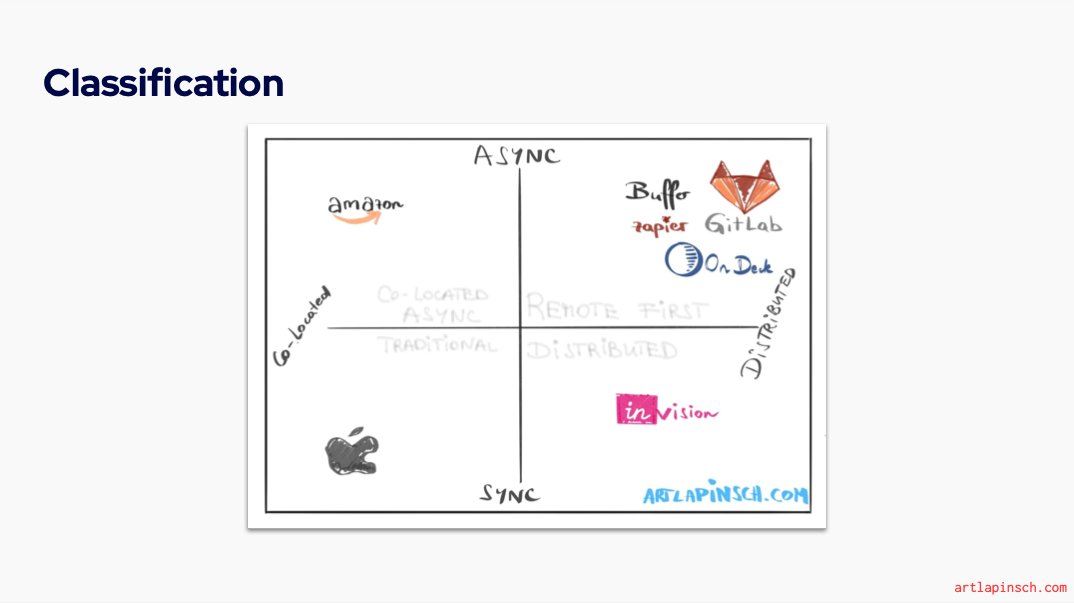 orgs are usually distributed + asynch/t @leonardofed" title="Businesses can be analyzed across 2 dimensions1) Location: Co-located vs. Distributed2) Synchronicity of Work: Synchronous vs. AsynchronousRemote first https://abs.twimg.com/emoji/v2/... draggable="false" alt="🏝️" title="Einsame Insel" aria-label="Emoji: Einsame Insel"> orgs are usually distributed + asynch/t @leonardofed" class="img-responsive" style="max-width:100%;"/>
orgs are usually distributed + asynch/t @leonardofed" title="Businesses can be analyzed across 2 dimensions1) Location: Co-located vs. Distributed2) Synchronicity of Work: Synchronous vs. AsynchronousRemote first https://abs.twimg.com/emoji/v2/... draggable="false" alt="🏝️" title="Einsame Insel" aria-label="Emoji: Einsame Insel"> orgs are usually distributed + asynch/t @leonardofed" class="img-responsive" style="max-width:100%;"/>
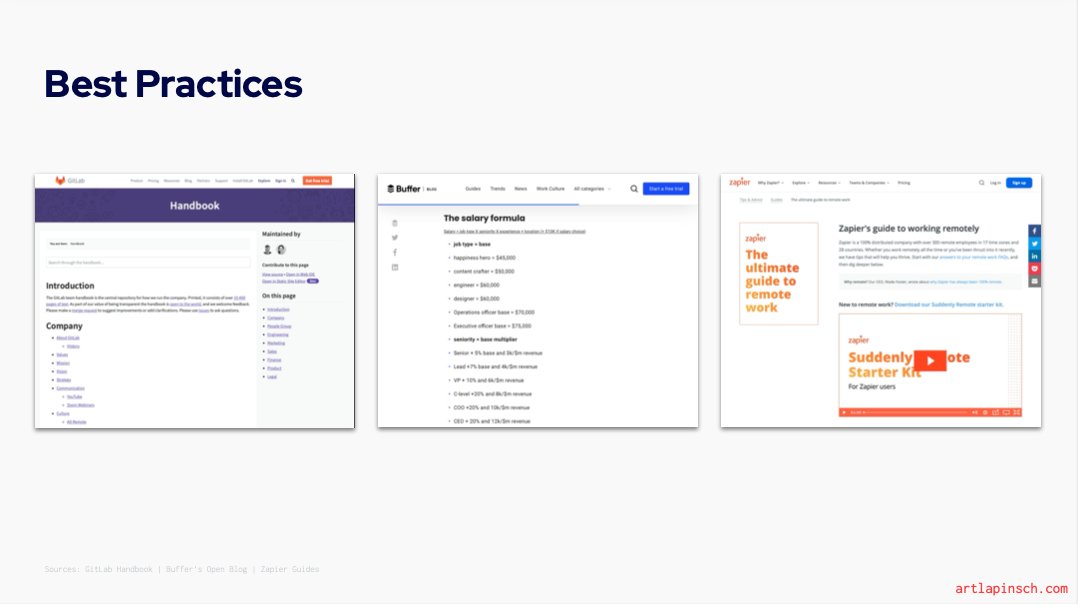
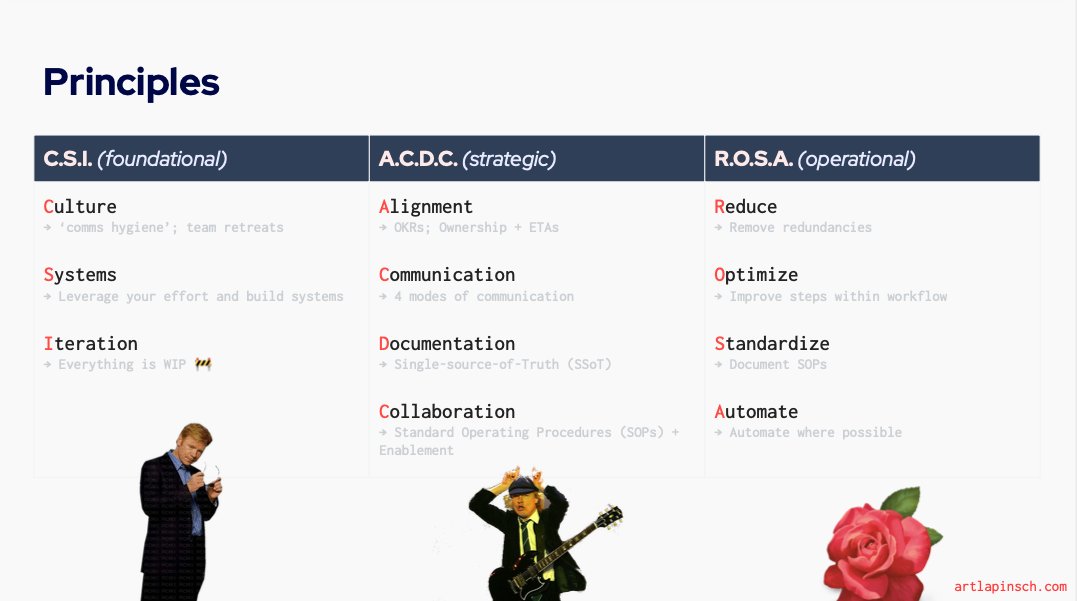 C.S.I.https://abs.twimg.com/emoji/v2/... draggable="false" alt="⚡" title="Hochspannungszeichen" aria-label="Emoji: Hochspannungszeichen"> A.C.D.C.https://abs.twimg.com/emoji/v2/... draggable="false" alt="🌹" title="Rose" aria-label="Emoji: Rose"> R.O.S.A.Detailed description in the imagehttps://abs.twimg.com/emoji/v2/... draggable="false" alt="👇" title="Rückhand Zeigefinger nach unten" aria-label="Emoji: Rückhand Zeigefinger nach unten">" title="Our guiding principles:https://abs.twimg.com/emoji/v2/... draggable="false" alt="🕶️" title="Dunkle Sonnenbrille" aria-label="Emoji: Dunkle Sonnenbrille"> C.S.I.https://abs.twimg.com/emoji/v2/... draggable="false" alt="⚡" title="Hochspannungszeichen" aria-label="Emoji: Hochspannungszeichen"> A.C.D.C.https://abs.twimg.com/emoji/v2/... draggable="false" alt="🌹" title="Rose" aria-label="Emoji: Rose"> R.O.S.A.Detailed description in the imagehttps://abs.twimg.com/emoji/v2/... draggable="false" alt="👇" title="Rückhand Zeigefinger nach unten" aria-label="Emoji: Rückhand Zeigefinger nach unten">" class="img-responsive" style="max-width:100%;"/>
C.S.I.https://abs.twimg.com/emoji/v2/... draggable="false" alt="⚡" title="Hochspannungszeichen" aria-label="Emoji: Hochspannungszeichen"> A.C.D.C.https://abs.twimg.com/emoji/v2/... draggable="false" alt="🌹" title="Rose" aria-label="Emoji: Rose"> R.O.S.A.Detailed description in the imagehttps://abs.twimg.com/emoji/v2/... draggable="false" alt="👇" title="Rückhand Zeigefinger nach unten" aria-label="Emoji: Rückhand Zeigefinger nach unten">" title="Our guiding principles:https://abs.twimg.com/emoji/v2/... draggable="false" alt="🕶️" title="Dunkle Sonnenbrille" aria-label="Emoji: Dunkle Sonnenbrille"> C.S.I.https://abs.twimg.com/emoji/v2/... draggable="false" alt="⚡" title="Hochspannungszeichen" aria-label="Emoji: Hochspannungszeichen"> A.C.D.C.https://abs.twimg.com/emoji/v2/... draggable="false" alt="🌹" title="Rose" aria-label="Emoji: Rose"> R.O.S.A.Detailed description in the imagehttps://abs.twimg.com/emoji/v2/... draggable="false" alt="👇" title="Rückhand Zeigefinger nach unten" aria-label="Emoji: Rückhand Zeigefinger nach unten">" class="img-responsive" style="max-width:100%;"/>
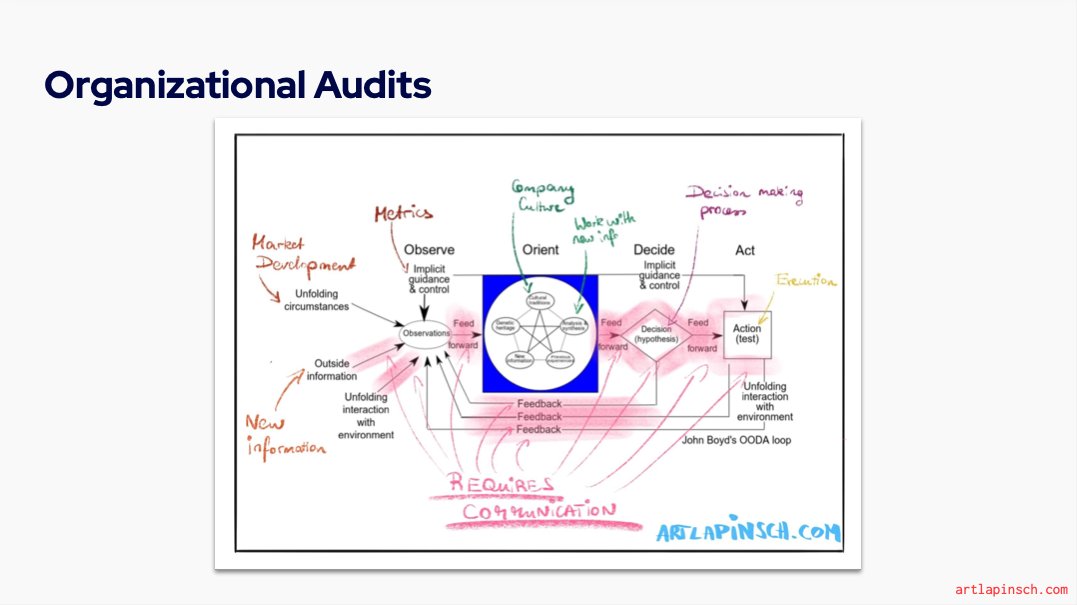 Observe: Metrics; Saleshttps://abs.twimg.com/emoji/v2/... draggable="false" alt="📊" title="Balkendiagramm" aria-label="Emoji: Balkendiagramm"> Orient: MKTGhttps://abs.twimg.com/emoji/v2/... draggable="false" alt="✅" title="Fettes weißes Häkchen" aria-label="Emoji: Fettes weißes Häkchen"> Decide: Managementhttps://abs.twimg.com/emoji/v2/... draggable="false" alt="🥊" title="Boxhandschuh" aria-label="Emoji: Boxhandschuh"> Act: Product; SalesIf information is siloed, you cannot go through the adaptation cycles as a collective org.Follow @commandodev" title="Communication is the life blood of any organizationView through OODA Loop:https://abs.twimg.com/emoji/v2/... draggable="false" alt="🔍" title="Nach links zeigende Lupe" aria-label="Emoji: Nach links zeigende Lupe"> Observe: Metrics; Saleshttps://abs.twimg.com/emoji/v2/... draggable="false" alt="📊" title="Balkendiagramm" aria-label="Emoji: Balkendiagramm"> Orient: MKTGhttps://abs.twimg.com/emoji/v2/... draggable="false" alt="✅" title="Fettes weißes Häkchen" aria-label="Emoji: Fettes weißes Häkchen"> Decide: Managementhttps://abs.twimg.com/emoji/v2/... draggable="false" alt="🥊" title="Boxhandschuh" aria-label="Emoji: Boxhandschuh"> Act: Product; SalesIf information is siloed, you cannot go through the adaptation cycles as a collective org.Follow @commandodev" class="img-responsive" style="max-width:100%;"/>
Observe: Metrics; Saleshttps://abs.twimg.com/emoji/v2/... draggable="false" alt="📊" title="Balkendiagramm" aria-label="Emoji: Balkendiagramm"> Orient: MKTGhttps://abs.twimg.com/emoji/v2/... draggable="false" alt="✅" title="Fettes weißes Häkchen" aria-label="Emoji: Fettes weißes Häkchen"> Decide: Managementhttps://abs.twimg.com/emoji/v2/... draggable="false" alt="🥊" title="Boxhandschuh" aria-label="Emoji: Boxhandschuh"> Act: Product; SalesIf information is siloed, you cannot go through the adaptation cycles as a collective org.Follow @commandodev" title="Communication is the life blood of any organizationView through OODA Loop:https://abs.twimg.com/emoji/v2/... draggable="false" alt="🔍" title="Nach links zeigende Lupe" aria-label="Emoji: Nach links zeigende Lupe"> Observe: Metrics; Saleshttps://abs.twimg.com/emoji/v2/... draggable="false" alt="📊" title="Balkendiagramm" aria-label="Emoji: Balkendiagramm"> Orient: MKTGhttps://abs.twimg.com/emoji/v2/... draggable="false" alt="✅" title="Fettes weißes Häkchen" aria-label="Emoji: Fettes weißes Häkchen"> Decide: Managementhttps://abs.twimg.com/emoji/v2/... draggable="false" alt="🥊" title="Boxhandschuh" aria-label="Emoji: Boxhandschuh"> Act: Product; SalesIf information is siloed, you cannot go through the adaptation cycles as a collective org.Follow @commandodev" class="img-responsive" style="max-width:100%;"/>
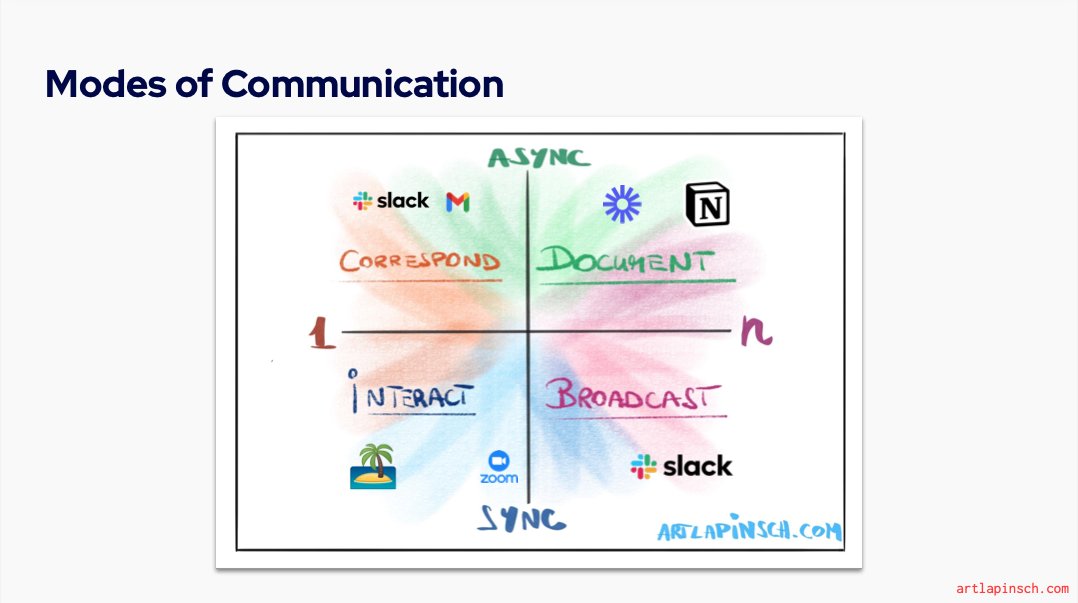 Reach: 1 vs. Nhttps://abs.twimg.com/emoji/v2/... draggable="false" alt="👀" title="Augen" aria-label="Emoji: Augen"> Context: Sync (= immediate feedback needed) vs. Async (= self-paced)* Transactional > Slack* Evergreen (solid-state) > Wiki; Notion" title="Different types of communication require different channelsThink of comms along 2 dimensions:https://abs.twimg.com/emoji/v2/... draggable="false" alt="🔊" title="Lautsprecher mit drei Schallwellen" aria-label="Emoji: Lautsprecher mit drei Schallwellen"> Reach: 1 vs. Nhttps://abs.twimg.com/emoji/v2/... draggable="false" alt="👀" title="Augen" aria-label="Emoji: Augen"> Context: Sync (= immediate feedback needed) vs. Async (= self-paced)* Transactional > Slack* Evergreen (solid-state) > Wiki; Notion" class="img-responsive" style="max-width:100%;"/>
Reach: 1 vs. Nhttps://abs.twimg.com/emoji/v2/... draggable="false" alt="👀" title="Augen" aria-label="Emoji: Augen"> Context: Sync (= immediate feedback needed) vs. Async (= self-paced)* Transactional > Slack* Evergreen (solid-state) > Wiki; Notion" title="Different types of communication require different channelsThink of comms along 2 dimensions:https://abs.twimg.com/emoji/v2/... draggable="false" alt="🔊" title="Lautsprecher mit drei Schallwellen" aria-label="Emoji: Lautsprecher mit drei Schallwellen"> Reach: 1 vs. Nhttps://abs.twimg.com/emoji/v2/... draggable="false" alt="👀" title="Augen" aria-label="Emoji: Augen"> Context: Sync (= immediate feedback needed) vs. Async (= self-paced)* Transactional > Slack* Evergreen (solid-state) > Wiki; Notion" class="img-responsive" style="max-width:100%;"/>
